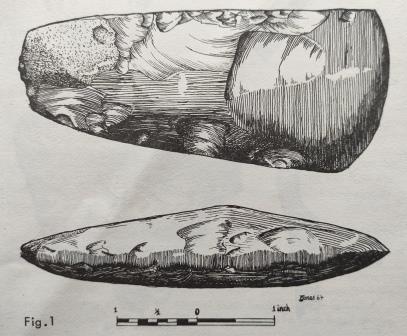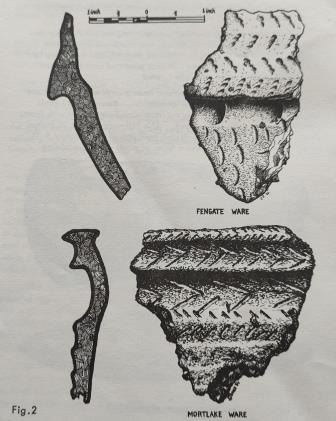THE DISCOVERY OF A SECONDARY-NEOLITHIC SITE AT HAYES 1966
West Kent Border Archaeological Group
The discovery of this site was largely a matter of chance. Indeed the great majority of archaeological sites are found in this way as a casual glance at the volumes of Archaeologia Cantiana or Victoria County Histories will readily reveal.
The story really began in 1960. It was then that members of the West Kent Border Archaeological Group commenced a series of surveys across farmland, through woods and on every available piece of open ground searching for both new and previously recorded sites. One of several 'missing' sites in the Bromley area was an alleged Roman building seen by an old inhabitant of the place early in the 19th century. It was not until the end of 1964, after extensive field-surveys and several trial-excavations over a wide area, that this building was eventually found. It was during the course of this work that a previously unknown Secondary-Neolithic site was found.
The investigations had eventually led the group to a heavily wooded region not far from Hayes Common. There it was decided to sink a series of three trial-holes and after the removal of undergrowth and other obstructions this was done. Within two hours the first trial- hole had produced evidence which was as startling as it was unexpected.
At a shallow depth small pieces of Roman tile and pottery were found, which were to lead eventually to the Roman building, but at a depth of 37 inches lay a complete, polished flint axe-head (fig. 1) of late-Neolithic type. This was the very first to have come from the Bromley area although two greenstone axe-heads had been recorded from the adjacent parish of Keston.
As the test-hole was extended a large fragment of a highly decorated bowl of Mortlake ware (fig. 2) was found and this too was clearly a late-Neolithic type. Of more than 400 test-holes dug by the group up to that time, none had ever produced such significant results. Clearly further work was needed.
At the end of 1964 the trees and undergrowth were cleared and a small area marked out for total excavation. Beneath the topsoil was a hard layer of pebbles from the Woolwich Beds, mixed with loam, washed down from the slope above. This hill-wash, up to 15 inches deep, contained worn Romano-British potsherds of first century A.D. date. Sealed beneath this was a layer of sandy-loam containing more material of Neolithic date. Slowly each part of the gridded area was excavated down to the undisturbed soil below. Six months later this preliminary examination had been completed and the site restored.
 |
 |
What did this excavation produce? No more flint axes, but over 1,000 pieces of struck flint were recovered. This was a striking-floor and the material from it forms an important group. The bulk of this naturally comprises waste primary flakes, but some 30 or 40 implements of various types were also found. These included discoidal and side scrapers, flakes with serrated edges, knives and several hammer-stones. The most interesting single piece was a leaf-shaped arrow-head, with fine pressure-flaking on both sides, another common Neolithic form. In addition several thousand 'pot- bollers', common to many pre-Roman sites, were also found.
Undoubtedly the most important single aspect of the work was the recovery of more than 200 pieces of pottery associated with the flints. Most of this was decorated either with broad chevron pat- terns, parallel grooves or with impressions made with bird-bones, finger-tips or twisted cords. Most, if not all, of this pottery can be classified as Peterborough ware of Secondary Neolithic date tentatively dating to about 2,000 B.C. Of the three sub-groups of Peterborough ware, Ebbsfleet, Mortlake and Fengate wares, all are probably represented at Hayes.
Of Mortlake ware, named after a fine bowl recovered from the Thames, there were at least two examples including the rim from the first trial-hole (fig. 2). These bowls are normally thick and round- bottomed and are very rare in Kent.
Of Fengate ware (fig. 2) six or seven examples are represented at Hayes and these are the first ever to be found in Kent. Normally these bowls have small, flat bases, a pronounced rim or collar and they often resemble the collared-urns of Wessex to which it seems they must relate. Indeed one of the closest parallels comes from the secondary filling of the West Kennet Long Barrow, close to Silbury Hill, Avebury and Windmill Hill. How strange to hear these household names being linked with Kent!
Of the Ebbsfleet sub-group, named after the site near Gravesend where it was first found, there are perhaps two or three sherds from Hayes. This ware is generally finer and the decoration more restrained. Significantly, perhaps, Windmill Hill and Rinyo-Clacton wares, strictly non-Peterborough types seem to be totally absent at Hayes.
The full significance of this impressive group of pottery is not yet known. Certainly no other group in either Kent or Surrey can compare and it will doubtless make a substantial contribution to our knowledge of the period. Happily, Dr. Isobel Smith, author of Windmill and Avebury (1965), has kindly agreed to examine all the pottery from the site and we must now wait for her detailed report.
Special efforts were made to locate any features, such as pits, ditches or post-holes, but none that could be connected with the Neo- lithic site was found. Perhaps these remain to be discovered beyond the limits of our excavation, buried beneath large trees and tangled undergrowth.
What of the future? The number of occupation-sites of Neolithic date known in Kent can be counted on a single hand. Of course there must be very many more waiting to be discovered, but the task is not an easy one. Kent alone covers more than 1,500 sq. miles; the sites are seldom extensive and the evidence from these can so easily be missed on building sites and farms. Each new site can make a considerable contribution to archaeological knowledge both in Kent and offer far beyond. This it seems is a question of priorities. Emergencies apart, rather the discovery of prehistoric sites than yet another Roman villa.
(Drawings by Christopher Jones)
Brian Philp
